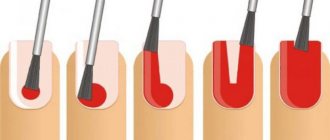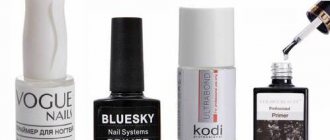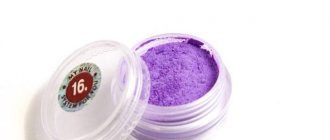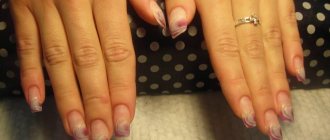Are you making artificial turf in the hope that it will last a long time, but literally after a week chips appear? Nail primer is an invisible protection and a tool that will help extend the life of your manicure. How does he do this? What functions does it perform? How not to get confused by names, types and buy what you really need? Let's figure it out.
Primer and bond
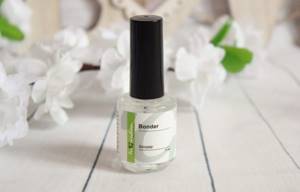
The confusion that arose in the names was caused by the metamorphosis of the primer as the nail industry developed:
- Initially, when the gel system first appeared, manufacturers presented a gel product for preparing the nail plate for applying a base. The primer had a dense texture and required drying in a UV lamp.
- Over time, the primer was improved to a liquid so as not to add excess thickness to the coating. The new product is called Bond. The new formula quickly took root in the offices of craftsmen, but not all manufacturers switched to the new name, leaving the “primer” familiar to many, which in fact is no longer a primer in the usual sense.
Now the stores offer both bond, primer, and ultrabond, although the properties of these products are identical.
To close this issue forever and put things in order, let’s look at 3 formulations - Bonder from the Ingarden brand, Ultrabond Kodi and Yoko acid-free primer.
| Ingarden Bonder | Kodi, Ultrabonder | Yoko, Primer |
| Ethyl acetate 2,2-bis(4(2-hydroxy,3-methacryloxypropoxy) bis-glycol methacrylate 2-hydroxyethyl methacrylate | Ethyl acetate Isopropylidene diphenyl bioxyhydropropyl methyl acrylate 2-hydroxyethyl methacrylate | Ethyl acetate Isopropyldiphenyl methacrylate Hydroxyethyl methacrylate |
As you can see, the compositions of the drugs are almost identical, with minor exceptions in the form of safer or less safe additives. When choosing a primer, keep in mind that primer, bond and ultrabond are one and the same.
What can replace the primer?
Like everything you need, the primer tends to run out at the most inopportune moment. In such situations, it is urgently necessary to replace it with a product whose properties will be close to the original version.
These often include the following:
- nail polish remover containing acetone, but without oils;
- alcohol or cologne;
- table vinegar.
Any of these homemade alternatives can dry out the surface of the nail, but none of them guarantee the result that the primer gives. Therefore, for a high-quality manicure, you should always have a specialized product.
The best acid primers
Despite the aggressiveness of the composition, some masters and their clients prefer acidic liquids, so we will highlight the best of them.
Rio Profi
The product with methacrylic acid is intended for high-quality degreasing of nails before the extension procedure. It is recommended to use the product after treating the nail plate with a buff and degreasing with liquid.
- Drying time in open air is 2-3 minutes.
- Suitable for working with acrylic and gel systems.
Interview with the top manager of the Rio Profi brand
RuNail, Strong
The product with an enhanced formula is recommended for those with “wet” nails, as well as for those who often experience peeling of the coating.
Suitable for treating nails before applying all known products - gels, gel polishes and acrylics. Despite the presence of methacrylic acid in the composition, the product has a mild chemical odor.
Kinetics
The Latvian brand offers an acid primer to prevent peeling. Used when working with gels and acrylics. After drying, it leaves a slight stickiness that does not require removal. Drying time – 60 seconds.
TNL
Fills all cracks and irregularities, making the nail perfectly smooth and even, making it easier to work with the base layer. Time from application to complete drying is 3 minutes.
Kodi
Professional acid primer to improve adhesion between the coating and the nail. Air dry in 1-2 minutes. Has a distinct odor. The only drawback is the brush with soldered hairs.
Irisk, Primer for acrylic
Suitable for use with acrylic systems only. When working with gels and gel polishes it does not give the desired effect. Dries in 30-40 seconds, creating an ideal surface for modeling nails.
What is a nail primer?
A primer (translated from English as “primer” means “primer”) is a special product for enhancing adhesion when preparing nails for artificial coating. It dries and degreases the nail plate, acts as double-sided tape - both sides have adhesive (gluing) functions - thereby improving the adhesion between the nail and the artificial material.
The primer does not create a separate layer of coverage and usually has a liquid texture. It does not require the use of a manicure lamp as it dries perfectly in air within a minute. The main value of the primer is that thanks to it, in the most vulnerable places - the end and along the edges of the nail plate - the coating does not chip and lasts as long as possible.
The Best Acid-Free Primers
Rio Profi
A universal acid-free product for working with different types of coatings - gel varnishes, single-phase varnishes, acrylic. Complete drying time – 2-3 minutes. It has a specific, but not too pronounced odor.
Grattol
A universal product helps improve adhesion and degrease the nail plate. Dries in 60 seconds. Does not have a pungent odor.
CND NailPrime
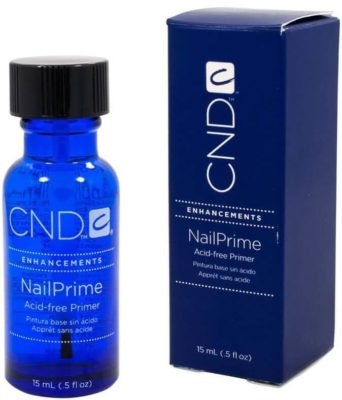
The gentle composition minimizes the occurrence of allergies and at the same time demonstrates good adhesion. Used to work with gels, acrylics, gel polishes.
UNO LUX
Improves nail adhesion to acrylic, gel or gel polish without overloading the nail plate with harmful components. Suitable for women with frequent peeling of varnish, as well as peeling nails.
ORLY, GelFx
The product contains substances to improve adhesion, as well as vitamins for nail care. Dries in 30 seconds and leaves a perfectly smooth surface. The manufacturer recommends applying the composition only to potentially problematic areas - the free edge and side rollers.
Patrisa nail, Primer pencil
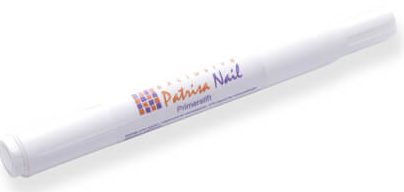
The primer in the form of a pencil allows you to control the application process and avoid tipping the bottle. Suitable for working with gel systems and gel polishes.
Using a primer in the manicure procedure is not at all a mandatory step.
Despite the availability of relatively safe products, you should not further injure the nail plate. Well, if the coating on your nails peels off after just a couple of days, choose acid-free products and do not neglect safety precautions. Do you use primer? Tell us in the comments which brand you like best. Comment
How to properly apply primer to nails?
Stage 1: Cuticle treatment and nail shaping
Before applying the primer, you need to get your nails in order: treat the cuticles and give your nails a beautiful shape. At this stage we will need:
- orange stick;
- pusher;
- cuticle remover;
- scissors, tweezers or nippers for removing cuticles;
- file for natural nails.
Orange sticks medium 17.8 cm IRISK 90-100 pcs
Manicure pusher P-06 small spatula/hatchet length 132 mm Nippon Nippers
Universal product for removing artificial turf Remover ParisNail 950 ml
Double-sided file LNF-О7Н Solinberg
Leather cutters with spring (cutting part 7mm) NS-30-7 STALEX
What are we doing?
- Using a file, give the free edge the desired shape;
- Apply cuticle remover to the cuticle and side rollers;
- Place your hand in a bath of warm water for 3-4 minutes. We wipe our fingers and start manicure;
- Use a pusher to push back the cuticle;
- Remove the cuticle with scissors (tweezers, nippers);
- With an orange stick dipped in water, we go along the contour of the nail and clean the pterygium.
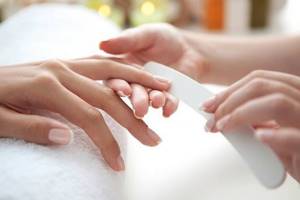
Stage 2: Preparing the nail plate
Next, we begin to prepare the nail plate for coating with gel polish. At this stage you will need a primer! This stage is very important, since it determines how well the adhesion of the natural nail and the artificial coating will occur.
To carry out proper preparation, you will need the following materials:
- buff;
- brush or brush for removing dust;
- lint-free wipes;
- 2 in 1 liquid: degreaser and sticky layer remover;
- dehydrator (nail prep);
- primer
Buff mini 100/180 White Monami 50 pcs
E.Mi Dust Brush
Lint-free hard napkins 5.5*4 cm pink Lunail
Degreasing and lubricant remover with pump Eurocleanser Lux E.MiLac 200 ml
Nail dehydrant “Dry nail” Nayada 25 ml
Acid primer NeoNail 10 ml
What are we doing?
- We treat the surface of the nail plate with a buff to lift the scales of the nail plate and improve adhesion;
- Remove dust with a special brush;
- Apply degreaser to a lint-free cloth and wipe your nails;
- For those with wet, oily nails, to improve adhesion, apply a dehydrator to the entire surface of the nail and air dry it for a minute. You can also apply a disinfectant;
- Then you need to apply primer to the free edge of the nail. Depending on the purpose and condition of the nails, we choose acidic or acid-free. The free edge is one of the most vulnerable places, and thanks to the primer, the adhesion between the nail plate and the artificial material improves, which contributes to longer wear of the coating. We also air dry the primer for one minute.

NOTE!
It is not necessary in all cases to use all preparatory means (degreaser, dehydrator, disinfectant, primer). This is only necessary when working with problematic, oily, wet nails. In other cases, you can get by with fewer products, for example, a degreaser and a primer.
Features of working with a primer
As mentioned above, not all products are safe for skin and nails, so we recommend taking into account the basic rules of operation. This will be especially true for those who plan to use it at home.
Many beginners don't know that you don't need to use a special lamp for primer. It air dries quite quickly. However, under no circumstances should it be used in small rooms with poor ventilation. The consequences can be very serious, so do not risk your health.
Before applying the primer, the surface of the nails must be prepared. That is, treat it with a special buff that helps remove unevenness. Also, at home, you should not apply more than one layer of the product. Of course, an experienced master sometimes uses two layers, but this is done in exceptional cases.

Please note that the primer must be dry before you apply any of the possible coating options. Otherwise, a beautiful manicure will definitely not work.

As you can see, a primer is a really necessary tool for creating a stylish manicure with gel polish, as well as for extensions. But you should still follow some rules so as not to harm your health. Especially when using an acidic substance.
What type of nail primer do you use? Share your experience in the comments.
How to choose a good product that applies well and lasts a long time
This material is presented in several types. The composition and principle of influence are their main differences. There are three main ones:
- prep primer;
- acid-free;
- acid.

Each of them is used in certain procedures, taking into account the condition of the nails and determining which is better is not so difficult.
Pre-primer - how to use the base
This remedy is considered a “light” option. Bond is his second name. Flavors and other aggressive substances (dyes) are not included in the composition. The effect of the prep is soft and delicate, not reaching the deep layers of the nails. Their water balance is maintained at the required level. They will not become dry and brittle.
Pre-primer is rarely used for extensions, since it cannot provide the necessary adhesion of the artificial material to the nail plate.
It is applied as a base coat under stronger types of primers to create additional protection for weakened nails that are prone to brittleness. Prep can be used by people who sweat excessively, as peeling of the artificial turf may occur. Read how to properly prepare and apply a hot hair mask here.
Acid-free
It does not contain acids, which ensures the safety of the procedure. It can be used even on fragile nails. The primer degreases perfectly.
As a result, good adhesion of the gel polish to the plate is achieved. If you use an acid-free product in accordance with all points of the instructions, its effect is not inferior to acidic primers.
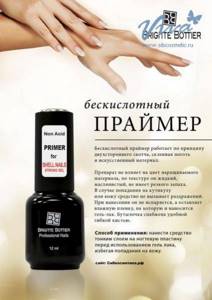
The skin, cuticle, and nail folds will not be damaged if a small amount of the product gets on them. But you still need to be careful when applying, as redness may occur with increased sensitivity. Acid-free primer is also used when applying pedicures.
Acid
Methacrylic acid is contained in this product ranging from 30% to 100%. The acid causes the nail to soften. The horny scales, when raised, provide reliable adhesion of the artificial covering to the treated surface. Read all about the benefits and harms of tar shampoo at this link.
Acid primer has its drawbacks. It's toxic. Methacrylic acid is highly active. When using, you must be extremely careful to avoid contact with the skin of your hands. Acid can cause redness of the skin area, severe burning, even chemical burns. His treatment is quite long.
This type of product can be applied to healthy, strong nail plates. It is better not to use it for thin and sensitive nails. He will ruin them completely. It is used for processing when carrying out acrylic extensions. An innovative foot cream – Deo Control – will quickly eliminate unpleasant foot odor.
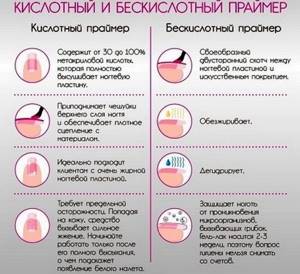
When buying a product, you need to focus not only on the cost. An important factor is the extent to which the manufacturer is known and reliable. By purchasing a primer from an unknown company, you can seriously harm your nails.
Useful video comparing acid and acid-free primers
Types and originality of each of them
Despite the abundance of brands and brands, all primers can be divided into two large categories: acidic and acid-free. They differ in physical and chemical properties and application features.
Acid-free
The principle of operation is that after applying the product, a sticky layer remains. Its formula tends to slightly change the natural PH and bring it closer in physical and chemical character to artificial turf, which is very alkaline by default. The gluing of the finishing layer is of the highest quality.
Acid-free types of primers are valued because they do not penetrate deep into the structure. They are completely safe. But they also have disadvantages. This is, for example, the lack of a disinfectant effect. Some specialists also refuse to work with it because they do not dry it.
That is, their use is only possible in combination with:
- dehydrator (removes excess moisture);
- degreaser (removes accumulated dirt and natural fat);
- disinfectant (destroys bacteria and fungi).
Taken together, the listed products provide decent quality. If you neglect any of them, you cannot guarantee the duration of wear.
The product is applied very thinly to avoid detachment. You can apply sliders, foil or stamping to it.
Decent options for acid-free primers are offered by the Odiva online store: BLUESKY, TNL, POLE.
Acidic
The main component of the product is methacrylic acid. Its presence in the formula ranges from 70% to 100%.
It penetrates very deeply into the structure and exfoliates (raises) the scales to which the finish clings. The gluing is very strong, even if the girl suffers from hyperhidrosis.
Despite its good performance characteristics, this tool is not always required. They resort to it if the master is dealing with an excessively wet surface. It is also indispensable for extensions.
The disadvantages of this option include the aggressive nature of methacrylic acid. Oversaturation is unacceptable! Harmful components do not evaporate and are not washed off from the surface. Therefore, the technique prescribes the application of no more than 2 layers (and even then very rarely). They should be as thin as possible. At the same time, a mandatory requirement of the technology is an indentation from the cuticle and lateral sinuses.
If the instructions are not followed, the plate may become thinner. Burns and various allergic reactions also occur. If you complain of a burning sensation, rinse with cold water immediately.
Due to the strong chemical smell, it is recommended to use a mask, gloves and safety glasses when working. If you constantly inhale methacrylic acid vapors during your shift, there remains a risk of developing chronic headaches and bronchitis. Sometimes there is a decrease in vision.
At the same time, it is the acidic “primer” that is characterized by bactericidal properties. When working with it, the formation of microbes and various bacteria is excluded.
When choosing a suitable product, you must carefully read the instructions from the manufacturer. It would also be a good idea to carefully study the label. Some primers are designed to work with acrylic, others - with gel.
In the electronic catalog of the Odiva store you can choose high-quality acid primers from the best manufacturers for professional manicure: RIO PROFI, EZFLOW, COSMOPROFI.
FAQ
Will gel polish last without primer?
It will, but very briefly. The “primer” works for adhesion. Without it, the decorative part simply will not be able to “grab” the smooth plane. After all, the gel polish itself has a fairly dense texture. When it hardens, it resembles an elastic synthetic crust. It will simply slide off if it is not “glued”.
What is the fundamental difference between the two types of primer?
No Acid “brings together” the pH of the artificial coating and the “native” nail. All acid-free products form a sticky area. This optimizes the clutch process.
The Acid Bbased option provides adhesion by exfoliating microscopic flakes.
Can a primer serve as a disinfectant?
Only acidic. It guarantees complete disinfection of the plate, eliminating favorable conditions for the development of bacteria.
Is drying necessary?
As soon as the master touches the brush (lightly!), the “primer” begins to “spread” over the entire surface. It doesn't need to be leveled. Moreover, it begins to dry almost immediately.
How to use nail primer? How to apply it correctly?
Only dotted, with strokes. The composition tends to spread. Swabs may involve direct contact with the skin. This will inevitably cause dryness. And if, through negligence, the brush is not properly squeezed, then a burn is possible.
Do I need to apply a second coat?
Most manufacturers emphasize no. The second is required extremely rarely - only when the plate is very oily.
Where can you buy a quality primer?
Products of this class must meet the highest quality criteria. Both the aesthetic performance and the health of the client depend on them. You should choose Acid Bbased especially carefully, since it contains methacrylic acid. At the same time, you can trust only sellers with a decent reputation. The multi-brand online store Odiva has everything for classic manicure.
The best products in the nail industry are designed to improve your skills and achieve perfect results. Explore the range and experiment with new products from Odiva!
What is a nail degreaser and dehydrator for?
Using dehydrator , the process of dehydration is carried out (hence the name) - that is, the removal of excess moisture from the surface of the nails and its deep drying, which increases the adhesion of materials (gel polish and gel) to the surface of the nail plate, which in turn increases the wear life long-term coating or artificial nails. The same process is called degreasing the nail plate, which led to the appearance of the name degreaser - it is this that most informatively displays the functions of this product. Unlike the first, the degreaser acts more superficially.
You can often find a 2 in 1 product: for degreasing nails and removing the sticky layer:
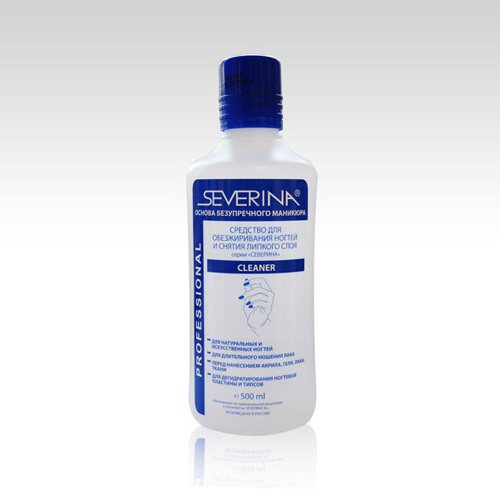
Recommendations from professionals
At the primer application stage, nail experts advise:
- when correcting, apply the composition only to the regrown part of the nail plate, and do not touch the part covered with the base layer;
- use a brush from a bottle, no matter how convenient another tool may seem;
- for soft nails with length, coat the end and free edge with an acidic agent, and the rest with ultrabond;
- be careful about the amount of product, as too much can cause burns;
- While the product dries, do not touch anything with your hands, otherwise the desired effect will not occur;
- if the skin around the nail is sensitive, protect it with a rich cream;
- When performing extensions on tips, avoid getting liquid on them.
A primer is not always needed when doing a manicure. But it significantly extends the wearing time if there are problems with this - detachments, chips, erasing of the coating from the ends. It is only important to choose a good product and not overdo it with its quantity.
Popular brands
Companies that offer the best ratio of quality and price:
- RuNail is a budget brand of quality products for nail extensions and manicure. The price is quite low, but the product provides reliable grip.
- CND is one of the oldest brands, standing at the very origins of nail extensions. The products are of very high quality, they are completely free of toxic components, but at the same time they are quite expensive.
- Mozart House is an Austrian brand that produces high-quality nail products. The price is lower than that of CND, but also not the lowest. However, the quality of the product is excellent: their primer is guaranteed to provide excellent adhesion.
- Lady Victory is another budget brand. Many craftsmen prefer to work with it, talking about its good quality and low cost.
To decide which primer to choose, listen to the advice of a professional:
Primer for regular varnish
This product can also be applied under regular varnish. It will serve as a primer layer, level the working surface of the nail and protect it from the penetration of chemicals. For those whose hands sweat a lot, the primer is a godsend. Under regular varnish, you can use a primer that does not contain acid.
Some manufacturing companies purposefully produce primers not only for gel and acrylic, but also for traditional varnish. For example, this is Yang nails with its acid-free product – Protein Bond. In tandem with varnish, you can also use a base coat.




